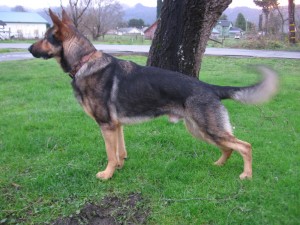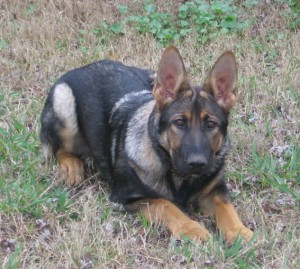Inappropriate Aggression
In our last blog, we discussed aggression in dogs. For the majority of pet dogs, there are four common reasons that can be implicated in inappropriate displays of aggression in the home. Three of these reasons rest squarely on the shoulders of the owner or handler, NOT on the dog!
While we discuss the most common causes of inappropriate aggression below, we do encourage anyone in the midst of this problem with their dog to consult a qualified dog trainer who is experienced with constructively handling aggression in dogs.
4 Common Causes of Inappropriate Aggression
1. Genetics and Temperament
Genetics plays a strong role in determining the temperament and personality of a dog. Each dog has a unique inherited package of genes that influence the way it views the world. Some dogs are naturally more confident and curious, others are more timid, some are more pushy, and some are more submissive.
Regardless of inherited temperament, all dogs should be socialized with the world at large. Genetically timid dogs are in even greater need of extensive socialization. The genetics of temperament are the hardest to “fix” or pin down in breeding, which is why it is important to choose the source of your dog carefully!

Some dogs inherit a lower threshold for environmental stimuli than others, and are much more aware of their surroundings.
Genetics also help determine how easily a dog feels threatened. Some dogs inherit a high threshold for threatening stimuli, while other dogs inherit a much lower threshold.
A ‘low threshold’ means it does not take much for this dog to feel worried or defensive; they are more aware of all the goings-on in their environment, and tend to be more reactive. Socialization can improve this somewhat, but these dogs still tend to be worriers who respond more quickly than others to environmental stimuli. Training can also improve this, while lack of training will worsen these temperament problems.
The owners of a dog with a weak temperament must work hard to provide their dog with appropriate dog training and socialization, so as to help their dog learn appropriate alternate behaviors for handling its fear or worry. Even then, the dog may always need some special care and management of its environment.
2. Too Much Freedom
This is an owner-caused source of inappropriate aggression in the home. The dog or puppy has been given free rein of the home from the beginning, with very little structure or discipline. As a result, the dog has learned that he can do whatever he wants, wherever he wants, whenever he wants. Now, when asked to do something contrary to what he wants to do — such as getting off the couch or bed so a person can sit there — the dog protests with a growl or a snap. One of the first steps that can be taken with a dog like this is to reduce the freedom this dog has been given.
Dogs need structure in their lives, particularly during those first two formative years. This can be attained by controlling their access to food, toys, and living space, and by training desired behavior early on (see #3). A crate will greatly help with this, serving not only as a place of structured rest and relaxation, but as a place for an excited or angry dog to calm down and refocus. The dog can earn increasing freedom through reliable behavior and good manners.
3. Lack Of Clear, Consistent Training
This is a very common owner-caused reason for inappropriate aggression. Many people confuse positive training with being permissive, showing an unwillingness to set clear boundaries and enforce them because they think “being positive” means “no discipline or correction”. The result is an out-of-control dog that thinks it makes the rules, lacks self-control and discipline, and has created self-rewarding behavior patterns (which can include displays of aggression over food, toys, or territory).
Positive does not mean permissive! A dog can be trained positively in a reward-based manner while still establishing and enforcing clear, consistent expectations of behavior. Appropriate correction can be used to enforce the rules as long as it is safe, effective, clear, and fair —always fair — to the dog. The dog needs to have the knowledge of and opportunity to choose the correct behavior in order for the correction to be fair. A clear change in behavior should be seen after a correction (even a verbal “NO” should result in a behavior change), and the dog should immediately be given the opportunity to perform (and be rewarded for) the desired behavior.

Desirable behavior must be trained and reinforced. This 5-month-old puppy has already learned a distance "down" command.
Desirable behavior must be trained and reinforced — it doesn’t just “happen”! The dog must be instructed in what behaviors you want the dog to perform. Particularly for genetically confident and pushy dogs, early training is a must, in order to show the dog what behaviors are desired and what will be rewarded.
Commands should be clear and consistent among all family members; only ONE command should be given and reinforced. All family members should be involved in the training of the dog, so that the dog learns from the beginning that all family members are not only associated with good things, but are also to be respected.
4. Ignoring The Behavior
This is our last owner-caused contributor to inappropriate aggression, and it is typically combined with one or more of the above factors. The most common lament heard with this is: “We thought the puppy would grow out of it!” Many people wait too long before attempting to train their now-adolescent dog. By this point, the dog has had over four months to satisfy its desires in any way it chooses, rather than being directed in its learning!
Instead of teaching appropriate behavior early on, many people simply avoid the situation that elicited the unwanted behavior, mistakenly believing that “training positively” means ignoring any unwanted behavior. Perhaps this works when it comes to teaching the “sit” or the “down”, but some unwanted behaviors must not be ignored, including any early attempts at inappropriate aggression like resource guarding, growling at the food bowl, growling when being touched or handled, etc.
Choosing to ignore the handler is another behavior that is often tolerated and reinforced simply by doing nothing about it. These must be addressed immediately the FIRST time they happen in a young dog, rather than being left alone until it becomes a real problem.
Discipline, Structure & Training
It is the lack of discipline, lack of structure, and lack of appropriate training that results in the needless surrender of many dogs to shelters. And in the majority of “aggressive” cases, it is a combination of these four factors listed above that have shaped the resultant aggressive behavior.

